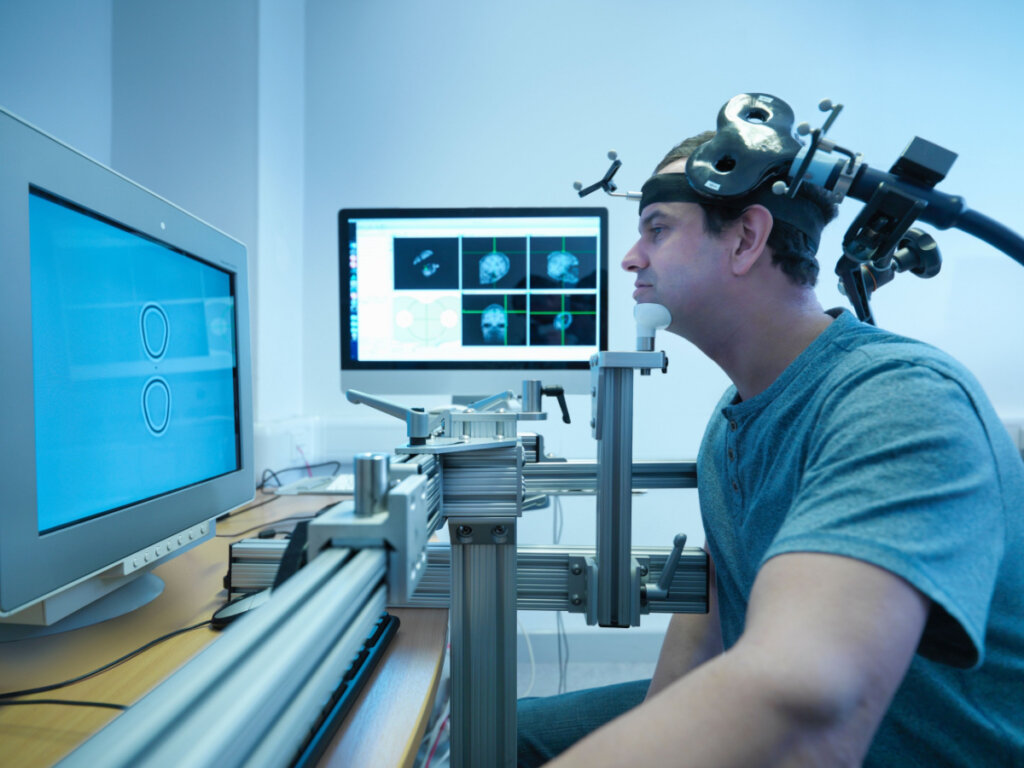Transcranial Magnetic Stimulation: A Treatment for Depression


Reviewed and approved by the psychologist Sergio De Dios González
Transcranial magnetic stimulation (TMS) is a procedure that’s carried out to treat depression in cases in which psychotherapy or drugs haven’t achieved results. It’s a condition that’s known as treatment-refractory depression. This procedure seeks to stimulate the cerebral cortex. More specifically, it produces electrical changes in the neurons with the aim of changing the perception and behavior of the sufferer.
This treatment is also used in other disorders. For instance, Parkinson’s disease, schizophrenia, epilepsy, pain disorders, autism, ADHD, and motor disorders of various kinds. In this article, we’ll explain transcranial magnetic stimulation and what a patient can expect from it.
“Depression is a prison where you are both the suffering prisoner and the cruel jailer.”
Dor0thy Rowe

Transcranial magnetic stimulation
Transcranial magnetic stimulation is an intervention method that’s based on the application of magnetic fields. This is carried out in a controlled manner. The aim is to stimulate the activity of the nerve cells.
EMT uses electromagnetic impulses to depolarize the neuronal membrane. If this is achieved, an ‘action potential’ appears in the cells. In effect, they begin to emit electrical signals capable of properly regulating synapses (the connections between nerve cells). This improves or corrects the transmission of information in the nervous system.
Occasionally, diseases such as depression affect the neuronal membrane. Sometimes, it’s necessary to stimulate it so that it recovers its normal function. At other times, it’s inhibited, with the same objective. The specialist in charge of carrying out these procedures is a clinical neurophysiologist.
The procedure
The first thing an individual with refractory depression should do is attend a medical evaluation. At this appointment, the medic will confirm that the patient presents a state of health compatible with the method. Moreover, they’ll confirm that there are no contraindications for applying transcranial magnetic stimulation.
Before starting each session, the patient must protect their ears with a barrier element, such as earplugs or something similar. Sometimes, it’s necessary to apply a sedative before carrying out the procedure. Once the patient is prepared, they enter a room, where a coil with an electromagnet is placed on their scalp.
After this, the neurophysiologist carries out brain mapping. This is a general exploration of the areas to be stimulated. Once they’ve located the relevant area, they turn on the coil and apply the stimulation, in a regulated manner. As a rule, it increases the motor threshold. This occurs when the patient’s fingers start to contract. Then, the doctor passes the magnetic field over the brain for a variable amount of time.
Transcranial magnetic stimulation must be carried out in a medical center. However, it doesn’t require hospitalization. Typically, each session lasts 30 minutes. Doctors usually recommend that the treatment is applied daily, for a period of 20 to 25 days.
Possible side effects and contraindications
Generally speaking, transcranial magnetic stimulation is safe. However, it may cause headaches, dizziness, tingling, or prickly sensations on the face or scalp in some people. Sometimes, slight spasms occur in these areas. Very occasionally, a patient may experience more serious side effects. These include hearing loss, seizures, or psychotic episodes. For this reason, it’s extremely important that professionals use the treatment with caution.
As for contraindications, the main ones are as follows:
- Use of pacemakers.
- Use of cochlear or nervous system implants.
- Dental implants.
- Presence of shrapnel or metallic elements inside the body.
- Recent cerebrovascular accidents.
- Pregnancy.

Effectiveness
Transcranial magnetic stimulation can dramatically decrease symptoms of depression. In fact, it can even make them disappear completely. Patients usually see the first results a few weeks after starting treatment. In some cases, it’s possible that, after applying the procedure, the doctor will recommend continuing with the more conventional treatments for depression (psychotherapy and drugs).
In some cases, a single series of sessions is enough to eliminate the symptoms of depression. At other times, patients later require second or third treatments. If the treatment doesn’t generate any visible effects, the doctor will suggest what path should be followed.
Transcranial magnetic stimulation (TMS) is a procedure that’s carried out to treat depression in cases in which psychotherapy or drugs haven’t achieved results. It’s a condition that’s known as treatment-refractory depression. This procedure seeks to stimulate the cerebral cortex. More specifically, it produces electrical changes in the neurons with the aim of changing the perception and behavior of the sufferer.
This treatment is also used in other disorders. For instance, Parkinson’s disease, schizophrenia, epilepsy, pain disorders, autism, ADHD, and motor disorders of various kinds. In this article, we’ll explain transcranial magnetic stimulation and what a patient can expect from it.
“Depression is a prison where you are both the suffering prisoner and the cruel jailer.”
Dor0thy Rowe

Transcranial magnetic stimulation
Transcranial magnetic stimulation is an intervention method that’s based on the application of magnetic fields. This is carried out in a controlled manner. The aim is to stimulate the activity of the nerve cells.
EMT uses electromagnetic impulses to depolarize the neuronal membrane. If this is achieved, an ‘action potential’ appears in the cells. In effect, they begin to emit electrical signals capable of properly regulating synapses (the connections between nerve cells). This improves or corrects the transmission of information in the nervous system.
Occasionally, diseases such as depression affect the neuronal membrane. Sometimes, it’s necessary to stimulate it so that it recovers its normal function. At other times, it’s inhibited, with the same objective. The specialist in charge of carrying out these procedures is a clinical neurophysiologist.
The procedure
The first thing an individual with refractory depression should do is attend a medical evaluation. At this appointment, the medic will confirm that the patient presents a state of health compatible with the method. Moreover, they’ll confirm that there are no contraindications for applying transcranial magnetic stimulation.
Before starting each session, the patient must protect their ears with a barrier element, such as earplugs or something similar. Sometimes, it’s necessary to apply a sedative before carrying out the procedure. Once the patient is prepared, they enter a room, where a coil with an electromagnet is placed on their scalp.
After this, the neurophysiologist carries out brain mapping. This is a general exploration of the areas to be stimulated. Once they’ve located the relevant area, they turn on the coil and apply the stimulation, in a regulated manner. As a rule, it increases the motor threshold. This occurs when the patient’s fingers start to contract. Then, the doctor passes the magnetic field over the brain for a variable amount of time.
Transcranial magnetic stimulation must be carried out in a medical center. However, it doesn’t require hospitalization. Typically, each session lasts 30 minutes. Doctors usually recommend that the treatment is applied daily, for a period of 20 to 25 days.
Possible side effects and contraindications
Generally speaking, transcranial magnetic stimulation is safe. However, it may cause headaches, dizziness, tingling, or prickly sensations on the face or scalp in some people. Sometimes, slight spasms occur in these areas. Very occasionally, a patient may experience more serious side effects. These include hearing loss, seizures, or psychotic episodes. For this reason, it’s extremely important that professionals use the treatment with caution.
As for contraindications, the main ones are as follows:
- Use of pacemakers.
- Use of cochlear or nervous system implants.
- Dental implants.
- Presence of shrapnel or metallic elements inside the body.
- Recent cerebrovascular accidents.
- Pregnancy.

Effectiveness
Transcranial magnetic stimulation can dramatically decrease symptoms of depression. In fact, it can even make them disappear completely. Patients usually see the first results a few weeks after starting treatment. In some cases, it’s possible that, after applying the procedure, the doctor will recommend continuing with the more conventional treatments for depression (psychotherapy and drugs).
In some cases, a single series of sessions is enough to eliminate the symptoms of depression. At other times, patients later require second or third treatments. If the treatment doesn’t generate any visible effects, the doctor will suggest what path should be followed.
All cited sources were thoroughly reviewed by our team to ensure their quality, reliability, currency, and validity. The bibliography of this article was considered reliable and of academic or scientific accuracy.
- de la Cal, A. M. (2004). Utilización terapéutica de los campos magnéticos. I: Fundamentos del Biomagnetismo. Patología del aparato locomotor, 2(1), 22-36.
- Leon-Sarmiento, F. E., Granadillo, E., & Bayona, E. A. (2013). Presente y futuro de la estimulación magnética transcraneal. Investigación Clínica, 54(1), 74-89.
- Sánchez Batista, I. (2014). Trastornos motores y trastornos del lenguaje: una perspectiva desde la lingüística clínica.
This text is provided for informational purposes only and does not replace consultation with a professional. If in doubt, consult your specialist.







